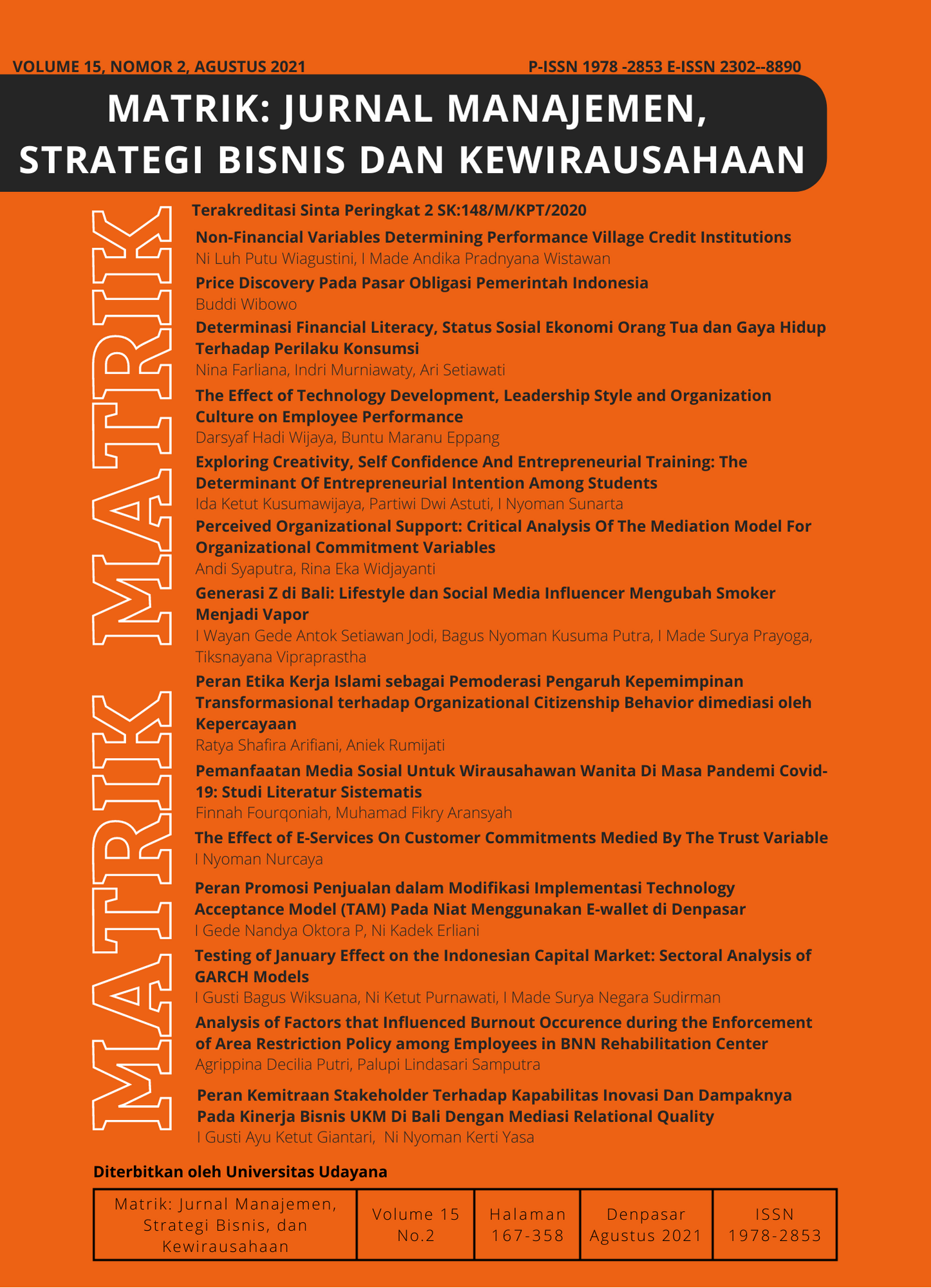Testing of January Effect on the Indonesian Capital Market: Sectoral Analysis of GARCH Models
Abstract
January Effect is the stock returns in January are higher than other months. This study uses the Generalized Autoregresive Conditional Heteroscedasticity (GARCH) method to test and analyze the January Effect in the Indonesian capital market from 2000 dd. 2018. The novelty of this study is a research methodology that classifies samples by sector and period on the January Effect test. The results of this study indicate that the January Effect occurs in several sectors and period. The January Effect occurs in the mining sector, consumer goods sector, property sector, and trade sector. Thus, the results of this study confirm the tax loss selling hypothesis and window dressing hypothesis in several sectors and observation periods. This shows that the January Effect is related to the characteristics of the sector and the period of observation.
Downloads
References
Berges, A., Mcconnell, J. J., & Schlarbaum, G. G. (1984). The Turn-of-the-Year in Canada. The Journal of Finance, XXXIX(1), 185–192.
Brown, P., Keim, D. B., Kleidon, A. W., & Marsh, T. A. (1983). Stock Return Seasonalities and The Tax-Loss Selling Hypothesis: Analysis of the Arguments and Australian Evidence. Journal of Financial Economics, 12(1), 105–127.
Chou, P., Ho, P., & Ko, K. (2012). Do Industries Matter in Explaining Stock Returns and Asset-Pricing Anomalies ? Journal of Banking and Finance, 36(2), 355–370. https://doi.org/10.1016/j.jbankfin.2011.07.016
De Long, J. B., Shleifer, A., Summers, L. H., & Robert, J. W. (1990). Noise Trader Risk in Financial Markets Andrei Shleifer. Journal of Political Economy, 98(4), 703–738.
Dickey, D. A., & Fuller, W. A. (1979). Distribution of the Estimators for Autoregressive Time Series With a Unit Root. Distribution of the Estimators for Autoregressive Time Series With a Unit Root., 74(366), 427–431.
Engle, R. F. (1982). Autoregressive Conditional Heteroscedasticity with Estimates of the Variance of United Kingdom Inflation. Econometrica, 50(4), 987–1007.
Eyuboglu, K., & Euboglu, S. (2016). Examining the January Effect in Borsa Istanbul Sector and Sub- Sector Indices. International Journal of Economic Perspectives, 10(2), 102–109.
Fama, E. F. (1965). The Behavior of Stock-Market Prices. The Journal of Business, 38(1), 34–105.
Fama, E. F. (1970). Efficient Capital Markets: A Review of Theory and Empirical Work. The Journal of Finance, 25(2), 28–30.
Gu, A. Y. (2003). The Declining January Effect : Evidences From the U . S . Equity Markets. The Quarterly Review of Economics and Finance, 43(2), 395–404.
Gultekin, M. N., & Glutekin, N. B. (1983). Stock Market Seasonality: International Evidence. Journal of Financial Economics, 12(4), 469–481.
Halari, A., Helliar, C., & Power, D. M. (2018). Taking Advantage of Ramadan dan January in Muslim Countries. Quarterly Review of Economics and Finance. https://doi.org/10.1016/j.qref.2018.05.018
Hou, K., & Robinson, D. T. (2006). Industry Contentration and Average Stock Returns. The Journal of Finance, LXI(4), 1927–1956.
Kato, K., & Schallheim, J. S. (1985). Seasonal and Size Anomalies in the Japanese Stock Market. The Journal of Financial and Quantitative Analysis, 20(2), 243–260.
Keim, B. (1983). Size-Related Anomalies and Stock Return Seasonality. Journal of Financial Economics, 12(1), 13–32.
Lamont, O. A. (2001). Economic Tracking Portfolios. Journal of Econometrics, 105(1), 161–184.
Lintner, J. (1965). Security Prices, Risk, and Maximal Gain From Diversification. The Journal of Finance, 20(4), 587–615.
Merton, R. C. (1987). American Finance Association A Simple Model of Capital Market Equilibrium with Incomplete Information. The Journal of Finance, 42(3), 483–510.
Moller, N., & Zilca, S. (2008). The Evolution of The January Effect. Journal of Banking & Finance, 32(3), 447–457. https://doi.org/10.1016/j.jbankfin.2007.06.009
Mossin, J. (1966). Equilibrium in a Capital Asset Market. Econometrica, 34(4), 768–783.
Philip, P. C. B. ., & Perron, P. (1988). Testing for a Unit Root in Time Series Regression. Biometrika, 75(2), 335–346.
Porter, D. C., Powell, G. E., & Weaver, D. G. (1996). Portfolio Rebalancing, Institutional Ownership, and The Small Firm-January Effect. Review of Financial Economics, 5(1), 12–29.
Reinganum, M. R. (1983). The Anomalous Stock Market Behavior of Small Firms in January: Empirical Test for Tax-Loss Selling Effects. Journal of Financial Economics, 12(June), 89–104.
Ritter, J. R., & Chopra, N. (1989). Portfolio Rebalancing and the Turn‐of‐the‐Year Effect. The Journal of Finance, XLIV(1), 149–166.
Robins, R. P., & Smith, G. P. (2017). On Unmodeled Breaks in the Turn of the Year, Turn of the Month, and January Effects. The Financial Review, 52(4), 725–747.
Rozeff, S. M., & Kinney, R. J. (1976). Capital Market Seasonality: The Case of Stock Returns. Journal of Financial Economics, 3(4), 379–402.
Seif, M., Docherty, P., & Shamsuddin, A. (2017). Seasonal Anomalies in Advanced Emerging Stock Markets. The Quarterly Review of Economics and Finance, 66(November), 169–181. https://doi.org/10.1016/j.qref.2017.02.009
Sekaran, U., & Bougie, R. (2016). Research Methods For Business: A Skill Building Approach (7th ed.). Chicester: John Wiley & Sons.
Sharpe, W. F. (1964). Capital Asset Prices: A Theory of Market Equilibrium under Conditions of Risk. The Journal of Finance, 19(3), 425–442.
Sun, Q., & Tong, W. H. S. (2010). Risk and the January effect. Journal of Banking and Finance, 34(5), 965–974. https://doi.org/10.1016/j.jbankfin.2009.10.005
Thaler, R. H. (1987). Anomalies: The January Effect. Journal of Economic Perspectives, 1(1), 197–201. Retrieved from http://www.jstor.org/stable/1942958 .
Tinic, S. M., & West, R. R. (1984). Risk and Return: January vs. the Rest of the Year. Journal of Financial Economics, 13(4), 561–574.
Ullah, I., & Ullah, S. (2001). Market Efficiency Anomalies : A Study of January Effect In Karachi Stock Market. Journal of Managerial Sciences, X(1), 31–44.
Watchel, S. B. (1942). Certain Observations on Seasonal Movements in Stock Prices. The Journal of Business of the University of Chicago, 15(2), 184–193.
Yakob, N. A., Beal, D., & Delpachitra, S. (2005). Seasonality in the Asia Pacific stock markets. Journal of Asset Management, 6(4), 298–318.
 This work is licensed under a Creative Commons Attribution-ShareAlike 4.0 International License.
This work is licensed under a Creative Commons Attribution-ShareAlike 4.0 International License.

















